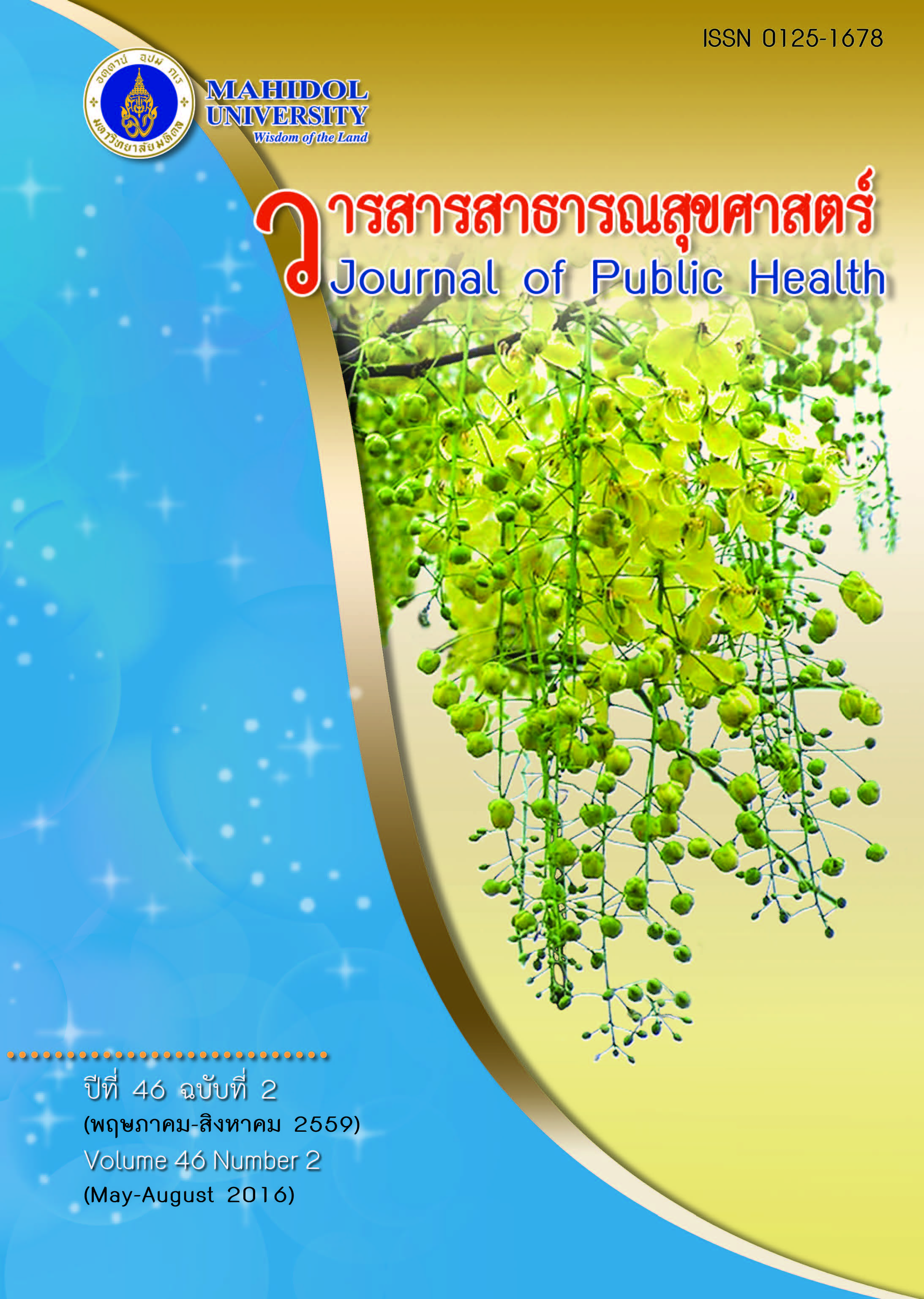ความเสี่ยงเชิงพื้นที่ของโรคไข้เลือดออกในประเทศไทย:ทบทวนข้อมูลระหว่างปี พ.ศ. 2549-2558
Keywords:
ไข้เลือดออก, ข้อมูลทุติยภูมิ, ระบบสารสนเทศภูมิศาสตร์, พื้นที่เสี่ยง, dengue fever, secondary data, geographic information system, risk areaAbstract
บทคัดย่อ
โรคไข้เลือดออกเป็นโรคที่เกิดจากเชื้อไวรัสเดงกี่ (Dengue Virus) โดยมียุงลายบ้านชนิด Aedes aegypti (L.) เป็นพาหะหลักในประเทศไทย ปัจจุบันแทบทุกพื้นที่ของประเทศเกิดการระบาดของโรคไข้เลือดออกอย่างต่อเนื่อง การกำหนดพื้นที่เป้าหมายการเกิดอุบัติการณ์ของโรคจึงเป็นสิ่งที่สำคัญ การศึกษาในครั้งนี้จึงมีวัตถุประสงค์เพื่อ ประเมินความเสี่ยงเชิงพื้นที่ของโรคไข้เลือดออกในระดับจังหวัดจากการประมาณค่าของตัวแปรที่กำหนด โดยทบทวนข้อมูลอุบัติการณ์ของจำนวนผู้ป่วยไข้เลือดออกต่อแสนประชากร พื้นที่ระบาดโรคไข้เลือดออกซ้ำซาก เชื้อไวรัสเดงกี่และความหนาแน่นของประชากรตั้งแต่ ปี พ.ศ. 2549-2558 ผลการศึกษาด้วยระบบสารสนเทศภูมิศาสตร์พบว่า จังหวัดที่ได้คะแนนความเสี่ยงของโรคไข้เลือดออกในระดับสูงมาก ได้แก่ เชียงราย เชียงใหม่ ลำพูน กรุงเทพมหานคร หนองคาย ชลบุรี ระยอง ราชบุรี และ ภูเก็ต และเมื่อซ้อนทับแผนที่แสดงความเสี่ยงของโรคกับพิกัดทางภูมิศาสตร์แสดงการต้านทานสารฆ่าแมลงในกลุ่ม Temephos และ Pyrethriod ของยุงลายบ้านชนิด Aedes aegypti ระหว่างปี พ.ศ. 2544-2552 พบว่า สถานการณ์การระบาดของโรคไข้เลือดออกในประเทศไทยมีแนวโน้มทวีความรุนแรงขึ้นทุกภูมิภาค โดยเฉพาะอย่างยิ่งที่ภาคเหนือ ภาคกลาง และภาคใต้ โดยเชื้อไวรัสเดงกี่ DENV-2 เป็นซีโรไทป์ที่มีสัดส่วนลดลง ในขณะที่ซีโรไทป์อื่น ๆมีสัดส่วนที่เพิ่มขึ้น การศึกษาครั้งนี้เป็นข้อมูลเบื้องต้นในการติดตามและเฝ้าระวังโรคไข้เลือดออกจึงควรมีการศึกษาเพิ่มเติมต่อไป
Spatial Risk Area for Dengue in Thailand: Reviewing Data
ABSTRACT
Dengue is a mosquito-borne tropical disease caused by the dengue virus and spread by Aedes aegypti (L.), the main vector in Thailand. This disease has been reported throughout the entire country. The national burden of the disease should be targeted and a dengue control program implemented. The objective of this study was to assess the spatial risk areas for dengue at the provincial level in Thailand by estimating the major factors that influence transmission of the disease. Data on dengue morbidity rates, areas of repeatedly high case reports, proportion of dengue virus and population density were reviewed between 2006 and 2015. The results from using Geographic Information System revealed that Chiang Rai, Chiang Mai, Lamphun, Bangkok, Nong Khai, Chonburi, Rayong, Ratchaburi and Phuket were predictably at very high risk of dengue transmission. Furthermore, a risk map was overlaid with the coordinates of temephos and pyrethroid resistance in Ae. aegypti, based on data from 2001 to 2009. An upward trend of dengue infection has been recognized dramatically across the country, especially in the northern, central and southern regions. A low proportion of DENV-2 cases has been observed, while other dengue serotypes have increased. However, this study can provide only basic information for monitoring dengue. Further study for dengue surveillance should be accomplished.
Downloads
Published
Issue
Section
License
Creative Commons License CC-BY-ND


